Japan today
IV Japan today
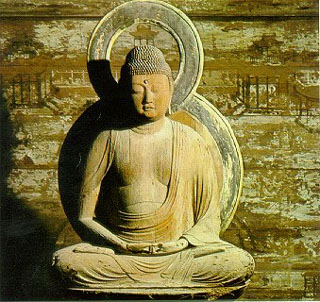
IV.1 Two complementary religions
There are many religions in Japan, and the sum of all religious affiliations (Buddhism, Shinto, Christianity...) comes to over 2.7 times the total population (!). This is because each person has more than one religion, a feature characteristic of Japan. While most Japanese are formally Buddhist, there is also a small Shinto altar next to the Buddhist altar in most homes. It is customary for people to go to both shrines and temples in the same way. Even if it seems very strange, it has persisted naturally since Buddhism's earliest days in Japan. The ancient Japanese believed that there were innumerable holy spirits in nature who were called Kami, and men performed religious ceremonies in order to call down their blessings and to ward off their curses.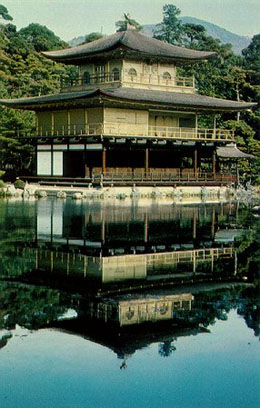 This is the origin of Shinto.
This is the origin of Shinto.Buddhism, when it was brought into Japan (cf. Part 2), felt that new religions weren't welcomed. In this sense, superstition played a major role in Japanese Buddhism throughout the ages. Today, Shinto rites are generally used to pray for the safety of new building projects, feasts such as weddings or New Year's Day, or to protect against accidents or plentiful harvests, whereas Buddhist ones are used for funerals (90 percent of total funerals), Bon (cf. Part 3.1), and otherwise to placate the dead. The two are intermixed in Japanese life.
IV.2 Contemporary specificities
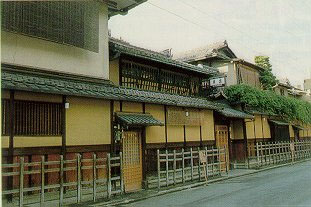 Japan still remains very specific for us, and its inhabitants too: they are said to have an inscrutable grin "the Japanese smile". Uneasy in its presence, non-Japanese don't understand this smile, and such criticism simply shows this lack of understanding; In fact, Japanese people have long avoided making direct and explicit judgements of good or bad. Instead, they are careful not to hurt other's feelings, and this has become an ingrained habit. In such ways, Japanese speech reflects the same behaviour pattern.
Japan still remains very specific for us, and its inhabitants too: they are said to have an inscrutable grin "the Japanese smile". Uneasy in its presence, non-Japanese don't understand this smile, and such criticism simply shows this lack of understanding; In fact, Japanese people have long avoided making direct and explicit judgements of good or bad. Instead, they are careful not to hurt other's feelings, and this has become an ingrained habit. In such ways, Japanese speech reflects the same behaviour pattern.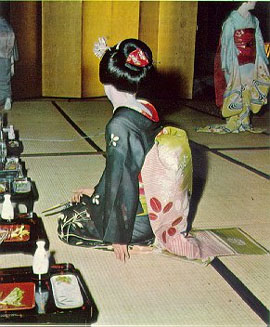 Even for its cuisine, Japan suffers critics. According to them, Japanese food only fills stomachs... But, Japanese cuisine just tries to stimulate palates; and it succeeds. Main dishes are famous sushis (made with fine rice, seasoned with vinegar, with fresh fish on top, people steep in a piquant sauce), sashimis (a variety of sliced raw fish served with a soy sauce and wasabi - between mustard and horseradish -), tempuras (a variety of deep-fried fish and seafood) and, of course, fugu (a fish whose liver secretes deadly poison; only a few chefs can prepare it...). But, warning, don't think the Japanese only eat fish; For, with pollution, fresh fish is more and more expensive and they equally appreciate pork, chicken, and pastries, especially French ones...
Even for its cuisine, Japan suffers critics. According to them, Japanese food only fills stomachs... But, Japanese cuisine just tries to stimulate palates; and it succeeds. Main dishes are famous sushis (made with fine rice, seasoned with vinegar, with fresh fish on top, people steep in a piquant sauce), sashimis (a variety of sliced raw fish served with a soy sauce and wasabi - between mustard and horseradish -), tempuras (a variety of deep-fried fish and seafood) and, of course, fugu (a fish whose liver secretes deadly poison; only a few chefs can prepare it...). But, warning, don't think the Japanese only eat fish; For, with pollution, fresh fish is more and more expensive and they equally appreciate pork, chicken, and pastries, especially French ones...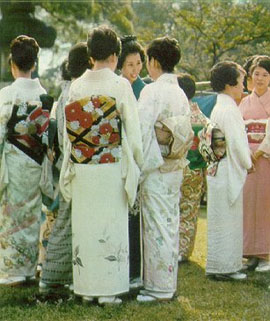 Kimonos represent a particularity too, which were born a long time ago: A Chinese history book written in the third century says that the Japanese cut holes in large pieces of cloth and wore them... Nevertheless, kimonos haven't changed a lot through all the period of history: First, kimonos were two pieces of clothing (an upper garment and a skirt) but, after the Kamakura period, they took the same form as we know today. Even if they are suitable for the Japanese climate, kimonos limit a person's movements so, today, people only wear them on special occasions such as New Year's Day and weddings. Moreover, their prices can even reach 160,000 Francs!
Kimonos represent a particularity too, which were born a long time ago: A Chinese history book written in the third century says that the Japanese cut holes in large pieces of cloth and wore them... Nevertheless, kimonos haven't changed a lot through all the period of history: First, kimonos were two pieces of clothing (an upper garment and a skirt) but, after the Kamakura period, they took the same form as we know today. Even if they are suitable for the Japanese climate, kimonos limit a person's movements so, today, people only wear them on special occasions such as New Year's Day and weddings. Moreover, their prices can even reach 160,000 Francs!